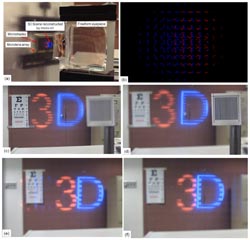Sight for Sore Eyes: Augmented Reality without the Discomfort
About
28 May 2014
Sight for Sore Eyes: Augmented Reality without the Discomfort
FOR IMMEDIATE RELEASE
Contact:
Lyndsay Meyer
The Optical Society
+1.202.416.1435
lmeyer@osa.org
Sight for Sore Eyes: Augmented Reality without the Discomfort
New goggle-like device may lead to 3-D augmented reality technology that minimizes visual fatigue

(a) Set-up of the experiment. (b) To create a 3-D scene, the micro integral imaging display combines many views of the scene from different perspectives. Here, a 3-D depiction of the characters "3D" is decomposed into its various perspective views. (c) – (f) These pictures show that the artificial 3-D image behaves as if it were a real object in front of you. In (c) and (d), the Snelling chart on the left is placed about 4 m away while the grating on the right is 30 cm away. The number "3" was created to appear farther away while the letter "D" appears closer. As a result, when the focus of the camera shifts from far (c) to near (d), so does the focus of the "3" and "D." When the position of the camera moves a little to the right from (e) to (f), the perspective of “3D" also slightly shifts. Credit: Optics Express.
Click image to see full size.
But one major limitation of this kind of augmented reality (AR) technology is that moving back and forth between a 2-D image on the screen and a 3-D world in front of you causes eye strain, unless you’re looking at something far away. Now a new device developed by researchers at the University of Arizona in Tucson and the University of Connecticut in Storrs is making AR technology easier on the eyes for short-distance applications, too, by superimposing 3-D images instead of 2-D. The authors describe their new approach in a paper published today in The Optical Society’s (OSA) open-access journal Optics Express.
"Minimizing visual discomfort involved in wearing AR displays remains an unresolved challenge," says first author Hong Hua of the University of Arizona. "This work is making a significant step forward in addressing this important issue."
A lightweight, compact and high-performance Google Glass-like device—called an optical see-through head-mounted display (OST-HMD)—could potentially be “a transformative technology to redefine the way we perceive and interact with digital information,” Hua says. For example, it could one day allow a doctor to see computed tomography (CT) images overlaid on a patient's abdomen during surgery or provide a new way to train soldiers by incorporating 3-D virtual objects into real-life environments.
AR goggles for long-distance viewing don’t always cause eye strain; some of these eye-friendly designs are actively used for military applications. But short-distance designs—in which you would focus simultaneously on a 2-D screen and a 3-D world immediately around you—do cause visual discomfort, due to the so-called accommodation-convergence mismatch problem.
"The eyes are going back and forth between the screen and the three-dimensional scene away from the screen, causing conflicting depth perception cues and visual fatigue," Hua explains.
The device developed by Hua and her colleague Bahram Javidi of the University of Connecticut solves this problem for OST-HMDs by superimposing a 3-D image, rather than the standard 2-D image, onto the 3-D view of the real world.
To create the 3-D image, the researchers developed a technology called microscopic integral imaging display. In this technique, a tiny, high-resolution screen produces views from different perspectives of the 3-D image you want to superimpose. The views then combine to reconstruct a 3-D scene that's sent through a specially shaped optical lens—called a freeform eyepiece—and into the eye. The lens, based on an emerging technology known as freeform optics, also allows you to directly see the real-life scene before you.
The result is a superimposition of a 3-D image onto a direct view of reality, allowing you to see the virtual image as if it were a real, 3-D object in the physical space in front of you. There's no conflict in how your eyes focus, giving you a much more comfortable version of augmented reality, Hua says.
Still, much work remains before the device is ready for commercialization, she says. In particular, the researchers hope to improve the depth and spatial resolution, as well as the viewing angle of the microscopic integral imaging technology and the freeform eyepiece. But due to rapid improvements in commercially available optical and optoelectronic devices, the prospects for commercialization are promising, Javidi adds.
Paper: “A 3-D integral imaging optical see-through head-mounted display,” H. Hua and B. Javidi, Optics Express, vol. 22, Issue 11, pp. 13484-13491 (2014).
EDITOR’S NOTES:
- Images are available to members of the media upon request. Contact Lyndsay Meyer, lmeyer@osa.org.
- Augmented reality and wearable displays is a featured topic at the upcoming OSA Imaging and Applied Optics: Optics and Photonics Congress, July 13- 17 in Seattle, Washington, USA. Bernard Kress, optics lead of the Google Glass Project, will be a plenary speaker, in addition to other invited and contributed talks on the topic. Reporters interested in obtaining a press badge to cover the OSA Imaging Congress should contact Lyndsay Meyer, lmeyer@osa.org.
About Optics Express
Optics Express reports on new developments in all fields of optical science and technology every two weeks. The journal provides rapid publication of original, peer-reviewed papers. It is published by The Optical Society and edited by Andrew M. Weiner of Purdue University. Optics Express is an open-access journal and is available at no cost to readers online at www.OpticsInfoBase.org/OE.
About OSA
Founded in 1916, The Optical Society (OSA) is the leading professional society for scientists, engineers, students and business leaders who fuel discoveries, shape real-world applications and accelerate achievements in the science of light. Through world-renowned publications, meetings and membership programs, OSA provides quality research, inspired interactions and dedicated resources for its extensive global network of professionals in optics and photonics. For more information, visit www.osa.org.
